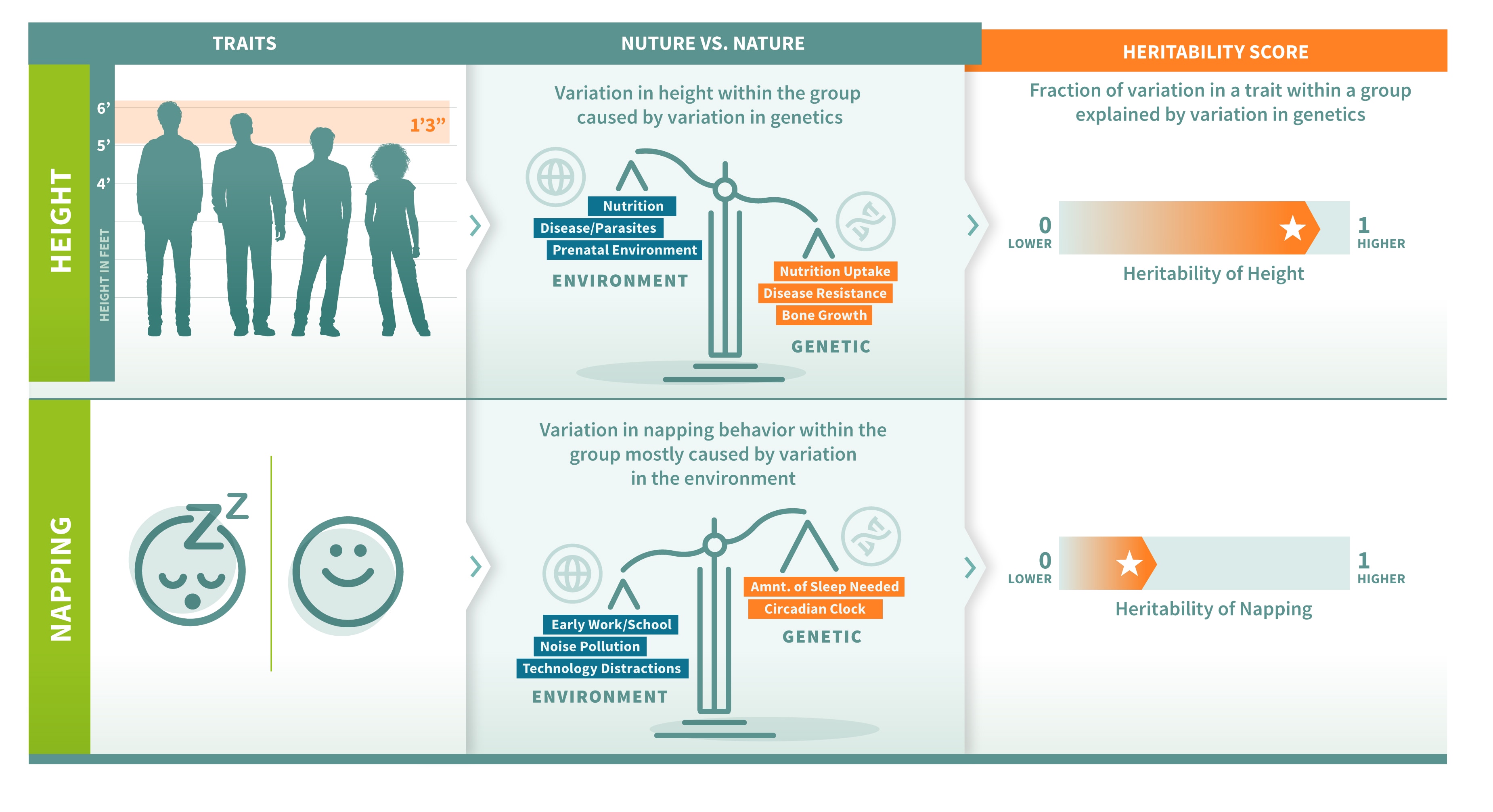Heritability
It’s easy to look at the people around us and see how much variation there is in physical appearance and behavior. But, how much of this variation is nature versus nurture? What did you genetically inherit from your biological parents versus how much did your environment play a role? Scientists in the fields of quantitative genetics and social sciences look for answers by studying heritability.
What Is Heritability?
Heritability is a measure of how much phenotypic variance for a trait—like eye color or height—can be attributed to genetic variance. Put another way, it’s how much the differences in peoples’ DNA can explain the visible or measurable differences in their physical traits and personality characteristics.
Why Is Estimating Heritability Important?
Estimating heritability is important because it gives scientists a sense of how genetics and environment are influencing a trait. For example, heritability measurements of health metrics—like Body Mass Index (BMI)—or lifestyle choices—like the age at which you get married—show that both environment and genetics impact our lives.
At Ancestry®, when we build a prediction tool for a trait like “risk taking,” we use heritability to gauge our prediction’s reliability. It helps us to more clearly understand the mix of effects, based on genetics and environment, of a trait.

What Does Heritability Tell Us about a Trait?
A trait’s heritability always lies between 0 and 1. A trait entirely determined by genetic factors, like blood type, has a heritability of 1. Many traits are determined by a mix of genetic effects and environmental effects. These traits have a heritability below 1. For example, height has a heritability close to 0.8, because it’s strongly influenced by the DNA you inherited from your biological parents and by environmental factors like early childhood nutrition and healthcare.
For a trait with low heritability, it’s not that there is no genetic component, just that it is outweighed by environmental factors.
A trait with high heritability does not mean there is a single genetic variant with a large effect. Traits can involve many genetic variants with small effects that combine to a large impact.
The estimated heritability for any trait may differ between groups of people and populations, but it’s likely to vary more for traits that have a lower heritability. This is because the variance in genetic effects and variance in environmental effects are specific to a population. Heritability is about a specific group of people and their environment. The heritability number does not say how much genetics or environment impacts a trait in any one person.
How Is Heritability Estimated?
Before collecting lots of genetic information was easy, estimates of heritability relied on studies of twins or families. Twin studies measured how correlated a trait was between “identical” twins, who share all of their DNA, and “fraternal” twins, who share half of their DNA. A larger difference between the identical and fraternal twins’ correlations meant a larger estimate of heritability. Twin studies were an effective way to control for environmental effects on a trait. Because twins grow up in the same house, they usually experience a shared environment.
Newer methods for estimating heritability use large sample sizes of unrelated people. They compare these people at millions of sites in their DNA throughout their genomes. These methods estimate the genetic similarity between individuals. They then compare that to the individuals’ trait similarity. This is known as SNP-based heritability. Peter Visscher and colleagues first validated this type of approach to estimate the heritability of height using genome-wide genetic variants.
What is the “Missing Heritability” Problem?
Early in the use of SNP-based heritability, researchers found much lower estimates for many traits than they had previously seen in family or twin studies. This became known as the “missing heritability” problem.
Explanations for the missing heritability problem included:
- The overlooked impact of variation in DNA structure
- Undiscovered rare genetic variants with large effects
- Unaccounted for common genetic variants with small effects
As studies increased in their sample size of individuals and genetic variants, they identified many common variants with small effects on the traits of interest. Accounting for these types of genetic variants helped close the gap between SNP-based and twin-based heritability estimates. This partly solved the missing heritability problem.
A final note: The term “heritability” is different from “heredity,” although they may sound similar. They aren’t, however, interchangeable terms. Heredity is about the process—the genetic transfer—of inheriting DNA from biological parents. Heritability, on the other hand, is a measurement—the ratio of genetic variance to phenotypic variance.
References
Macgregor, Stuart, Belinda K. Cornes, Nicholas G. Martin, et al. “Bias, precision and heritability of self-reported and clinically measured height in Australian twins.” Human Genetics. August 26, 2006. https://pubmed.ncbi.nlm.nih.gov/16933140/.
Maher, Brendan. “Personal genomes: The case of the missing heritability.” Nature. November 5, 2008. https://www.nature.com/articles/456018a.
Visscher, Peter M., William G. Hill, and Naomi R. Wray. “Heritability in the genomics era — concepts and misconceptions.” Nature Reviews Genetics. March 4, 2008. https://www.nature.com/articles/nrg2322.
Visscher, Peter M., Sarah E Medland, Manuel A. R Ferreira, et al.“Assumption-Free Estimation of Heritability from Genome-Wide Identity-by-Descent Sharing between Full Siblings.” PLoS Genetics. March 24, 2006. https://journals.plos.org/plosgenetics/article?id=10.1371/journal.pgen.0020041.
Wray, Naomi R., and Peter M. Visscher. “Estimating Trait Heritability.” Nature Education. Accessed January 3, 2023. https://www.nature.com/scitable/topicpage/estimating-trait-heritability-46889/.
Yang, Jian, Beben Benyamin, Brian P McEvoy, et al. “Common SNPs explain a large proportion of the heritability for human height.” Nature Genetics. June 20, 2010. https://www.nature.com/articles/ng.608.